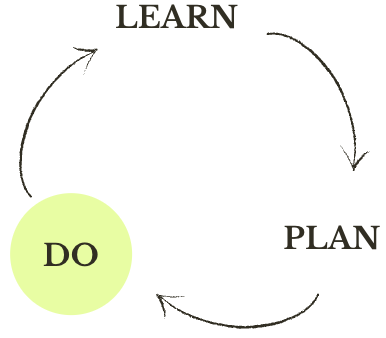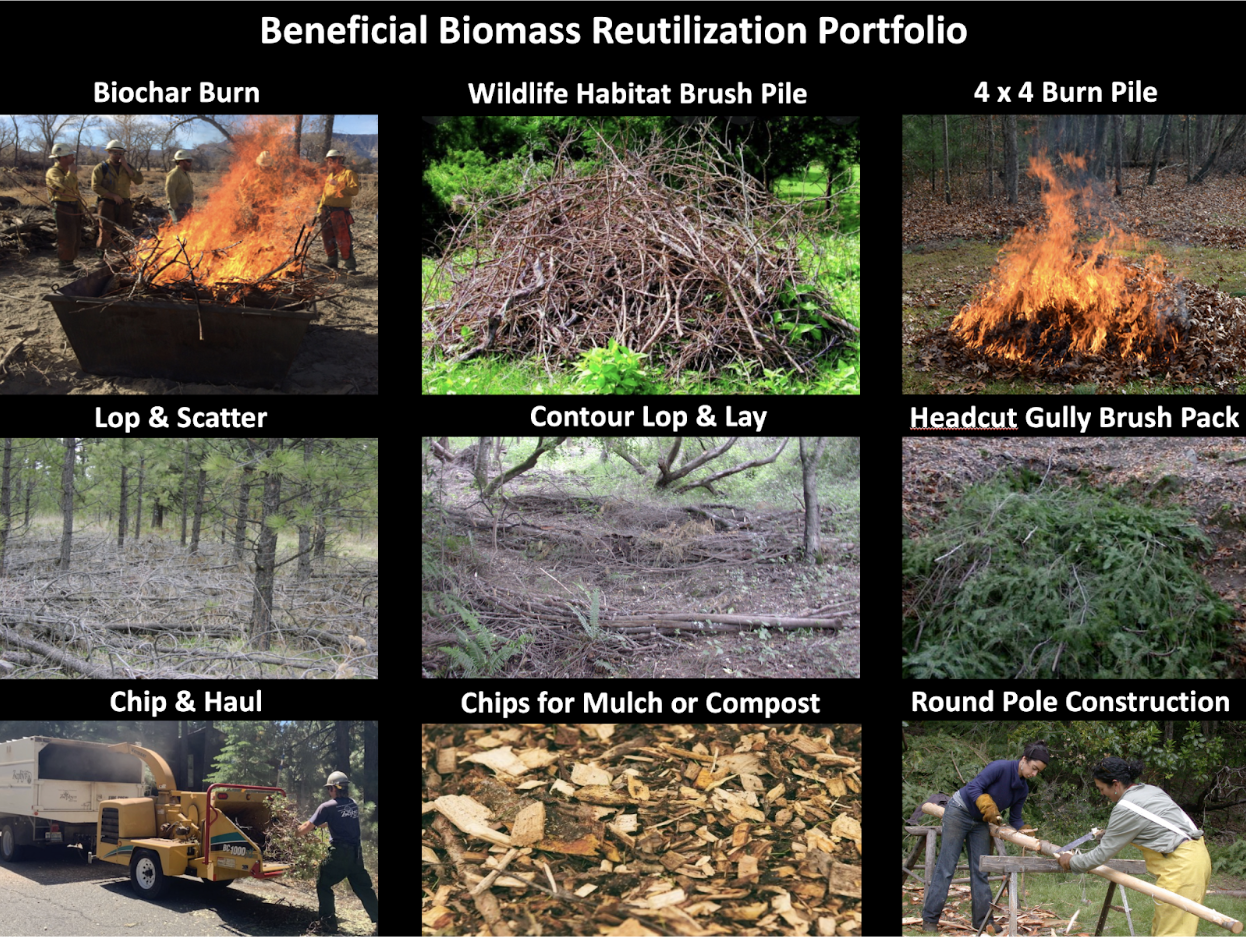DO THE WORK
Managing Woody Material, or… What to do with all that wood?
Most land management activities generate woody material, as do other processes such as ecological restoration, forestry, a naturally aging forest, or branches or whole plants dying from disease, pests, or fire.
It’s helpful to know how you are going to manage cut woody material before you start cutting, since planning ahead saves time and energy. Different Practices call for different lengths and sizes of material, so you’ll want to know how long to cut the pieces. Moving and restacking material is time-consuming, so ideally you’ll only sort and stack material once, with your next steps in mind.

Cutting is easy, managing the wood is the tricky part.

Image from Brock Dolman’s Beyond Defensible Space presentation
Such plans are particularly critical in cases when simply leaving the volume, weight, or size of the cut material on the ground would be harmful. Piles of branches, twigs, or logs can:
- Smother desirable understory vegetation
- Create a dangerous amount of fire fuel
- Make an area difficult to walk through
- Hinder wildlife movement
If cut material poses no problem, it can be left on the ground where it provides habitat for amphibians and many other animals, as well as food for decomposers and animals that feed on decomposers, from birds to bears.
The easiest way to reduce the burden of managing cut material is to cut and process less of it. Retaining nurse logs, snags, and stands of brush are all covered in Retaining and Creating Wildlife Habitat Features.
How to Choose What to Do with All that Wood
Each Practice offers its own requirements and benefits. Looking through the individual Practices can help you decide which methods are best for you.
It’s always good to use some of the material to make Wildlife Habitat Brush Piles, regardless of what other methods you also use.
Factors to help choose which practices to use:
- Can water be brought to the worksite?
- Water is necessary to make biochar (100-150 gallons minimum), support safe pile burning (10 gallons per pile location), or a beneficial fire (often a tanker truck known as a water tender)
- Can you get a vehicle to the worksite without causing damage to soils or vegetation?
- Vehicle access is necessary for Wood Chipping, the flame-cap kiln method of Making Biochar (no vehicle needed for conservation burn method), and except in rare instances, Beneficial Fire
- Is prescribed or cultural burning planned for the site?
- Woody material left on the ground via lop and scatter or chipping can dramatically influence fire behavior, increasing both fire intensity and the amount of time combustion will occur. Making Biochar or pile burning may be the best options if fire is expected on the site within the next ten years.
- Do you want to maximize climate benefit?
- Practices that keep carbon onsite until it decays: Lop and Scatter, Lop and Lay Brush Wattles, and Wood Chip and use onsite
- Practices that keep carbon onsite long-term (sequesters carbon) instead of sending it to the atmosphere: Making and Using Biochar and Headcut Gully Stuffing
- Practices that avoid or reduce emissions related to processing and hauling: to varying degrees, every method except Chipping and hauling
- Practices that reduce emissions compared to standard pile burning: Making and Using Biochar, Lop and Scatter, Lop and Lay Brush Wattles, Headcut Gully Stuffing, Wood Chipping (only short term emission reduction)
- Practices that create the most Greenhouse Gas (GHG) emissions, which are the main cause of global temperature increases, and other air pollution: chipping and standard pile burning. The harms created during the use of the practice must be compared with emissions and air pollution avoided during future wildfires. This is a complex trade-off.
- What size material are you working with?
- Very large material (over 12 inches in diameter) is best used or sold as timber or firewood
- Large material (eight to 12 inches in diameter) is best used in combination with small material for Retaining and Creating Habitat Features, for Lop and Scatter, or as firewood.
- Small material works for most practices, though for Retaining and Creating Habitat Features you’ll also need large material
- Consider using different methods of management for different sizes of material from the same worksite
- Does the work area have high-value vegetation such as native perennial grasses, close-packed forest overstory, or rare plants that could be harmed by certain methods?
- Wood chips, habitat piles, and burn piles shouldn’t be placed on valuable vegetation
- Avoid burning or placing habitat piles under low tree branches
- Are you able and willing to transport a large amount of material between six and 36 inches in diameter, in order to contribute to the development of a sustainable local wood economy?
- If so, contact Forestree Collective’s mill near Forestville to see if they can mill the wood
- Investigate using long straight poles for construction (Douglas fir work well). See here about making peeled poles and here about building with round poles
If you cut wood into firewood, use it within the local area, or get it inspected before giving or selling it to other locations. Firewood can carry pests and diseases that pose a serious threat to forests when infected wood is transported. The latest pest that travels in firewood is the gold-spotted oak borer.
Timing Considerations
Woody material is best managed immediately after, or within a few months, of the activities that created it. There are several potentially conflicting variables to consider before deciding when you will manage the material:
- Ideally, manage the material during the autumn and winter when there is a low risk of fire, but before the bird nesting season which is March through August.
- If you must use gas-powered tools or equipment do so before the day heats up, and on still days (days with little or no wind), to prevent starting fires. Take precautions such as having water and a shovel at hand, not setting hot tools on the ground, and avoiding contact with flammable materials.
- Avoid Managing Woody Material during bird nesting season, generally from March through August in Sonoma County. This timeframe covers nesting season for the majority of songbirds and raptors (birds of prey). If vegetation management must be done during nesting season, see Nesting Bird Surveys. Surveying over a longer period can protect more types of birds. For example,the Northern Spotted Owl can begin nesting as early as January in Sonoma County.
Related Practices
Making & Using Biochar Great for carbon capture and reducing air pollution.
Headcut Gully Stuffing Great for places with erosion damage and a surplus of small-diameter material (e.g. Douglas fir saplings, or broom)
Lop and Lay Brush Wattles Great for places with moderate to steep slopes and a surplus of small-diameter material (e.g. Douglas fir saplings, or broom)
Retaining & Creating Habitat Features Always a good use of some of your material.
Wildlife Habitat Brush Piles A good way to use woody material that could not remain in the place or form it was in.
Lop & Scatter A good method when you have a moderate or low amount of material.
Pile Burning Often the best available method on remote sites.
Wood Chipping Often used along roads and easily accessible sites or when wood chips are needed on site.
Beneficial Fire On many larger sites, the best method to aim for long-term.
Please note: this is a general guide. The specifics of how and when to do this practice will depend on many factors, including the site’s particular vegetation, climate and topography, history, and land management goals. Always consult with a professional if you’re unsure.
Do you have your principles in mind? Remember to regularly check in with your land management goals, to assure your practices and actions will actually achieve them.


